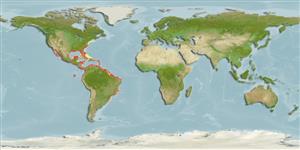Environment: milieu / climate zone / depth range / distribution range
Ekologi
laut; payau berasosiasi dengan karang; kisaran kedalaman 0 - 50 m (Ref. 96339). Subtropical; 43°N - 35°S, 116°W - 31°W
Western Atlantic: Maine, USA and northern Gulf of Mexico to Uruguay; throughout most of the West Indies (Ref. 3277). Absent from the Bahamas (Ref. 26938). Eastern Pacific: Baja California, Mexico to Ecuador (Ref. 9283). Two subspecies exists (Ref. 3277): Oligoplites saurus saurus (western Atlantic population) and Oligoplites saurus inornatus (eastern Pacific population).
Size / Weight / umur
Maturity: Lm ? range ? - ? cm
Max length : 35.0 cm TL jantan/; (Ref. 5217); common length : 27.0 cm TL jantan/; (Ref. 5217); Berat maksimum terpublikasi: 287.00 g (Ref. 3277)
Duri punggung (Keseluruhan (total)): 5 - 6; duri punggung lunak (Keseluruhan (total)): 19-21; Duri dubur 2-3; Sirip dubur lunak: 18 - 21. Body elongate and strongly compressed (depth from 3.5 to 4.4 times in standard length); posterior end of upper jaw reaching posterior rim of eye; upper jaw teeth small and villiform; lower branch of first gill arch with 14 to 18 gill rakers; scales small but visible, needle-shaped, embedded in the skin; back blue green; flanks and belly silvery to white, sometimes with yellow or golden highlights; pectoral and caudal fins yellowish (Ref. 55763); Dorsal fin has 5 nearly separate spines.
Adults are found inshore, usually along sandy beaches, in bays and inlets. They enter estuaries and fresh water, preferring turbid water. They occur in schools, usually large and fast moving, often leaping out of the water. Juveniles may float at the surface with tail bent and head down. Adults feed on fishes and crustaceans. The dorsal and anal spines are connected to venomous glands that can inflict painful wounds (Ref. 9283). Venom glands were not visible however, and cannot be confirmed in the specimen according to Smith and Wheeler, 2006 (Ref. 57406). Current information for this species as being dangerous need verification. Juveniles have incisor-like outer teeth and serve as cleaners for other fish; as fish grow, their teeth become conical and their diet changes (Ref. 26938). Marketed fresh and salted or dried but the flesh is not highly esteemed (Ref. 9283).
Life cycle and mating behavior
Kematangan | Reproduksi, perkembang biakan | Pemijahan | telur-telur | Fecundity | Larva
Smith-Vaniz, W.F., 1995. Carangidae. Jureles, pámpanos, cojinúas, zapateros, cocineros, casabes, macarelas, chicharros, jorobados, medregales, pez pilota. p. 940-986. In W. Fischer, F. Krupp, W. Schneider, C. Sommer, K.E. Carpenter and V. Niem (eds.) Guia FAO para Identification de Especies para lo Fines de la Pesca. Pacifico Centro-Oriental. 3 Vols. FAO, Rome. (Ref. 9283)
Status IUCN Red List (Ref. 130435)
penggunaan manusia
Perikanan: nilai komersial kecil; Ikan buruan: ya; umpan: occasionally
informasi lanjut
Nama-nama umumSinonim (persamaan)metabolismePemangsaEkotoksikologiReproduksi, perkembang biakanKematanganPemijahanSpawning aggregationFecunditytelur-telurpekembangan telor
AcuanBudidaya airprofil budidaya airStrainGenetikaElectrophoresesDiturunkanPenyakit-penyakitPengolahanNutrientsMass conversion
Alat, peralatan
laporan khas
muat turun XML
Sumber internet
Estimates based on models
Preferred temperature (Ref.
123201): 21.8 - 28, mean 25.5 °C (based on 554 cells).
Phylogenetic diversity index (Ref.
82804): PD
50 = 0.5312 [Uniqueness, from 0.5 = low to 2.0 = high].
Bayesian length-weight: a=0.00759 (0.00533 - 0.01079), b=2.87 (2.81 - 2.93), in cm total length, based on LWR estimates for this species (Ref.
93245).
Trophic level (Ref.
69278): 4.3 ±0.5 se; based on diet studies.
Daya lenting (Ref.
120179): Tinggi, Waktu penggandaan populasi minimum kurang dari 15 bulan (Preliminary K or Fecundity.).
Fishing Vulnerability (Ref.
59153): Low vulnerability (25 of 100).
Nutrients (Ref.
124155): Calcium = 43.3 [17.4, 91.0] mg/100g; Iron = 0.907 [0.475, 1.732] mg/100g; Protein = 20.7 [19.6, 21.8] %; Omega3 = 0.275 [0.157, 0.475] g/100g; Selenium = 13.3 [6.0, 26.5] μg/100g; VitaminA = 63.6 [18.5, 220.9] μg/100g; Zinc = 0.738 [0.467, 1.117] mg/100g (wet weight);
